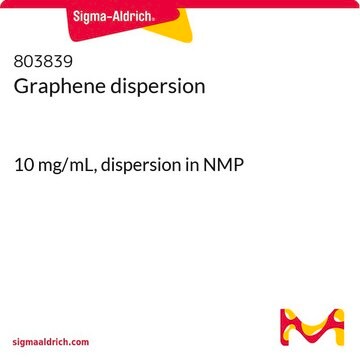As per the supplier, for spin-coating on glass, a standard iterative solvent cleaning protocol is recommended, involving 5 minutes of sonic cleaning in acetone, ethanol, and isopropanol, followed by blow-drying with N2 between each step, and then ozone plasma treatment (medium power for 2-5 minutes) to promote adhesion. The ink is also compatible with spin-coating on Si/SiO2 substrates, which can undergo the same pre-treatment protocol. When using the spin coater, spinning a single layer at 2000-5000 rpm results in a final film thickness of 40-60 nm. To achieve thicker films, multiple layers can be applied without a baking step, which is recommended over using a lower spin speed to maintain film uniformity. With 5 coats at 2000 rpm, a 200 nm thick film is obtained after baking at 300 °C for 30 minutes in air.
Kluczowe dokumenty
900960
Graphene dispersion
for spin/spray-coating, photonic annealing
Synonim(y):
Conductive ink, Graphene ink
Wybierz wielkość
1210,00 zł
Wybierz wielkość
About This Item
1210,00 zł
Polecane produkty
Nazwa produktu
Graphene ink for spin/spray coating photonically annealable, for spin-coating, spray-coating, photonic annealing
Poziom jakości
Formularz
dispersion (black)
charakterystyka ekologicznej alternatywy
Design for Energy Efficiency
Learn more about the Principles of Green Chemistry.
sustainability
Greener Alternative Product
stężenie
1.8-3.0 wt. % solids
rezystywność
0.003-0.005 Ω-cm, sample prepared by spin-coating at 2000 rpm/30 s for 5 coats, followed by thermal annealing at 300 °C in air for 30 minutes
wielkość cząstki
≤3 μm
lepkość
2-8 mPa.s(25 °C) (1000 s-1)
bp
78 °C (ethanol)
gęstość
0.78-0.88 g/mL at 25 °C
kategoria ekologicznej alternatywy
, Enabling
Powiązane kategorie
Opis ogólny
Zastosowanie
Spin-coating a single layer at 2000-5000 rpm yields a final film thickness of 40-60 nm. To achieve thicker films, multiple layers can be applied without a baking step. This is recommended over using a lower spin speed to maintain film uniformity. This ink should work on almost any substrate.
Electrical performance:
Following a baking step at 300 °C for 30 minutes in air, the spin-coated films exhibit sheet resistance of 300-800 Ω/sq, corresponding to a resistivity of 0.003-0.004 Ω−cm. With 5 coats at 2000 rpm, a 200 nm thick film with a sheet resistance of 160 Ω/sq. is obtained.
General guidelines:
Ethanol is recommended for cleaning up the ink and dried films, as well as dilution. Bath sonication (5-10 minutes) of the ink prior to use is recommended following extended periods of disuse.
Hasło ostrzegawcze
Danger
Zwroty wskazujące rodzaj zagrożenia
Zwroty wskazujące środki ostrożności
Klasyfikacja zagrożeń
Eye Dam. 1 - Flam. Liq. 2 - Skin Irrit. 2
Kod klasy składowania
3 - Flammable liquids
Klasa zagrożenia wodnego (WGK)
WGK 1
Temperatura zapłonu (°F)
54.5 °F - closed cup
Temperatura zapłonu (°C)
12.5 °C - closed cup
Wybierz jedną z najnowszych wersji:
Masz już ten produkt?
Dokumenty związane z niedawno zakupionymi produktami zostały zamieszczone w Bibliotece dokumentów.
Klienci oglądali również te produkty
-
Is there a documented recipe available for spin coating 900960, including details on the substrates it works well with (specifically regular glass slides), any pre-processing required to promote adhesion, the quantities needed, and the spin rpm-thickness characteristics?
1 answer-
Helpful?
-
Active Filters
Nasz zespół naukowców ma doświadczenie we wszystkich obszarach badań, w tym w naukach przyrodniczych, materiałoznawstwie, syntezie chemicznej, chromatografii, analityce i wielu innych dziedzinach.
Skontaktuj się z zespołem ds. pomocy technicznej












